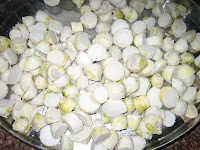
Chenai is known as Elephant Foot Yam in India. It is a favourite vegetable of the Keralites & is used in a lot of their dishes. It is grown in the backyard of almost all the houses in Kerala. The recipe i am giving today was given to me by my Sister-in law who got it from her grand mother. It is a yummy dish & is a vegetarian substitute for fish fry.
Preparation Time: 15 mts Cooking Time: 20 mts Serves: 2-3
Chenai - 250 gms
Tamarind - small lime sized ball
Besan flour (kadalai mavu) - 2 tbsp
Besan flour (kadalai mavu) - 2 tbsp
Rice flour - 1 tbsp
Chili powder - 1 tsp
Turmeric powder - 1/2 tsp
Refined oil - 2 tbsp
Refined oil - 2 tbsp
Salt - to taste

Remove the outer skin of the chenai. Slice it in to thin 1 inch square pieces. Squeeze the tamarind in 1 cup of water. Mix the besan flour, rice flour, chili powder, turmeric powder & in a plate. Put the chenai pieces in the  tamarind water & boil till the chenai is cooked. Drain the water & immediately roll it in the mixed flour. Heat a tawa & grease it with oil. Keep the pieces on the tawa. Pour oil all around & fry it on both sides till it is golden brown. Chenai tawa roast is ready.
tamarind water & boil till the chenai is cooked. Drain the water & immediately roll it in the mixed flour. Heat a tawa & grease it with oil. Keep the pieces on the tawa. Pour oil all around & fry it on both sides till it is golden brown. Chenai tawa roast is ready.
 tamarind water & boil till the chenai is cooked. Drain the water & immediately roll it in the mixed flour. Heat a tawa & grease it with oil. Keep the pieces on the tawa. Pour oil all around & fry it on both sides till it is golden brown. Chenai tawa roast is ready.
tamarind water & boil till the chenai is cooked. Drain the water & immediately roll it in the mixed flour. Heat a tawa & grease it with oil. Keep the pieces on the tawa. Pour oil all around & fry it on both sides till it is golden brown. Chenai tawa roast is ready. Variations:
Instead of making tawa roast, we can deep fry it in oil. The flour mix should be made in to a paste. The pieces should be dipped in to the paste & fried.
Tips:
- We can add asafoetida powder to the flour mix to give a nice flavour.
- Make sure that the chenai stays firm & is not over cooked.
- Sometimes the yam will be very hard. In such case, it can be cooked in a pressure cooker.
- Chenai has to be boiled in tamarind water or else it will irritate the tongue.
Taste it & enjoy.















































